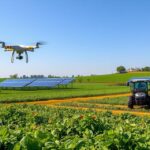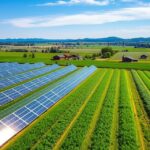Conventional gardening irrigation wastes up to 50% of water through inefficient methods. Solar-powered systems offer precise water management while reducing environmental impact. These systems are changing how we approach sustainable gardening.
DIY solar irrigation is an innovative approach to garden water management. It empowers homeowners to create efficient, eco-friendly watering systems. This method uses renewable solar energy to transform traditional irrigation into sophisticated, cost-effective strategies.
Solar-powered garden systems offer many benefits. They reduce utility costs and water consumption while improving plant health. Gardeners can now design custom irrigation solutions that fit their landscape needs.
This guide will teach you how to create a robust solar irrigation system. You’ll learn about selecting components and implementing advanced water distribution techniques. The result? A sustainable gardening solution that saves resources and boosts plant growth.
Building your own DIY solar irrigation system is an exciting project. It allows you to embrace green technology and improve garden maintenance. This guide is useful for both seasoned gardeners and sustainability enthusiasts.

Introduction to DIY Solar Irrigation Systems
Solar-powered irrigation is revolutionizing gardening. It offers a sustainable way to maintain healthy gardens. This innovative approach combines eco-friendly watering systems with cutting-edge technology.
Solar garden watering technology opens up exciting possibilities for gardeners. It represents a significant leap in sustainable gardening practices. This approach integrates solar energy into garden maintenance seamlessly.
Benefits of Solar-Powered Gardening
- Significant reduction in water and energy costs
- Minimal environmental impact
- Complete independence from electrical grid
- Low maintenance requirements
Environmental Impact of Solar Irrigation
Solar irrigation systems drastically reduce carbon footprints. They harness renewable energy for garden maintenance. Sustainable gardening is no longer a distant dream but a practical reality.
Gardens become powerful tools for environmental conservation. Simple irrigation transforms into an act of ecological responsibility.
“Every drop of water saved and every watt of solar energy used is a step towards a greener planet.” – Environmental Sustainability Expert
Overview of System Components
A typical solar-powered irrigation setup includes several key components:
- Solar panels
- Water pump
- Battery storage system
- Irrigation pipes and drippers
- Control mechanism
Gardeners can customize these systems to fit their landscape needs. Solar garden watering technology is versatile and adaptable. It works well with various garden sizes and types.
Planning Your Solar Irrigation System
A successful homemade solar irrigation system needs careful planning. Your DIY solar-powered garden irrigation project requires thoughtful preparation. This ensures optimal performance and efficiency.
Effective planning involves several critical steps. These steps shape your garden’s water management strategy. Understanding your needs helps create a custom solar irrigation solution.
Assessing Your Garden’s Water Needs
Knowing your garden’s water needs is crucial. This forms the base of an effective solar irrigation system.
- Plant types and their specific water demands
- Local climate and seasonal variations
- Soil composition and drainage characteristics
- Garden size and layout
Budgeting for Your Project
A DIY solar-powered garden irrigation system needs careful financial planning. Here are potential costs to consider:
| Component | Estimated Cost Range |
|---|---|
| Solar Panels | $100 – $500 |
| Water Pump | $50 – $250 |
| Irrigation Pipes/Tubing | $30 – $150 |
| Battery Storage | $100 – $400 |
Choosing the Right Location
Picking the best spot for your solar irrigation system is vital. Sunlight exposure, proximity to water sources, and terrain complexity affect your system’s effectiveness.
“The success of a solar irrigation system lies in its strategic placement and thoughtful design.” – Sustainable Gardening Expert
Look for areas with maximum sun exposure and minimal shade. Find spots with easy access to your garden’s water points. Consider elevation and ground stability when choosing the installation site.
Essential Components for Solar-Powered Irrigation
A DIY solar irrigation system needs carefully chosen key components. The right parts will help you build an efficient system. This setup will save water and energy in your garden.
Solar Panels: Powering Your Garden’s Irrigation
Picking the right solar panels is vital for a reliable garden water pump. Different panel types offer unique benefits for your project.
- Monocrystalline panels: High efficiency, ideal for smaller garden spaces
- Polycrystalline panels: More affordable, suitable for larger garden areas
- Thin-film panels: Flexible installation, good for irregular surfaces
Battery Storage: Ensuring Continuous Operation
Battery storage keeps your garden system running smoothly. The right battery ensures water delivery even on cloudy days. It also works during times with low sunlight.
| Battery Type | Capacity | Lifespan | Best For |
|---|---|---|---|
| Lead-Acid | 100-200 Ah | 3-5 years | Budget-friendly systems |
| Lithium-Ion | 200-400 Ah | 7-10 years | High-performance gardens |
| Gel Cell | 150-250 Ah | 4-7 years | Low-maintenance setups |
Pumps: Selecting the Best Type for Your Garden
Picking the right solar water pump depends on your garden’s needs. Think about your garden size, water source, and desired flow rate.
“The heart of any solar irrigation system is its pump – choose wisely, and your garden will thrive.” – Garden Technology Experts
- Centrifugal pumps: Best for shallow water sources
- Submersible pumps: Ideal for deep wells or water tanks
- Surface pumps: Excellent for consistent water pressure
Your DIY solar irrigation system’s success depends on matching parts to your garden’s needs. Choose components that fit your specific requirements for the best results.
Designing Your Irrigation Layout
An effective irrigation layout is vital for sustainable gardening. Your solar-powered setup needs careful planning for water efficiency and plant health. A good design can create a thriving, water-conscious garden ecosystem.
Comparing Irrigation System Types
Choosing the right irrigation method is crucial for your solar-powered setup. Two main systems are used in garden irrigation:
| Drip Irrigation | Sprinkler System |
|---|---|
| Delivers water directly to plant roots | Sprays water over larger garden areas |
| High water efficiency | Faster coverage of wide spaces |
| Minimal water waste | Better for lawns and ground cover |
| Ideal for vegetable gardens | Less precise water distribution |
Mapping Your Garden Layout
Effective garden mapping requires understanding your landscape’s unique features. Follow these steps for sustainable gardening solutions:
- Measure your garden’s total area
- Identify plant water requirements
- Note sun exposure and shade patterns
- Consider soil type and drainage
Ensuring Comprehensive Water Coverage
Proper water distribution is essential for plant health. Strategic placement of drip emitters or sprinkler heads ensures full coverage.
Calculate water needs based on plant types. Create zones for different irrigation requirements.
“A well-designed irrigation system is the backbone of a thriving, water-efficient garden.” – Sustainable Gardening Expert
Installing Solar Panels
Solar panels are key to eco-friendly garden watering. They offer sustainable and cost-effective irrigation solutions. Proper installation is crucial for maximum efficiency.
Tips for Optimal Placement
The right location for solar panels greatly impacts system performance. Consider these key factors:
- Choose areas with maximum direct sunlight exposure
- Avoid shadowy spots from trees or buildings
- Aim for a south-facing orientation in the Northern Hemisphere
- Ensure a minimum of 6-8 hours of direct sunlight daily
“The secret to effective solar garden watering technology is strategic panel placement.” – Renewable Energy Expert
Mounting Techniques for Stability
Secure mounting prevents damage and ensures consistent solar energy capture. Different mounting options include:
- Ground-mounted frames
- Roof-mounted racks
- Adjustable angle mounts
- Pole-mounted systems
Wiring Considerations
Proper wiring is vital for an efficient solar watering setup. Use weatherproof cables and ensure correct connections between components.
Waterproof connectors and underground conduits protect your system from environmental challenges. Professional advice can help optimize your eco-friendly watering system.
Setting Up the Pump System
Building a solar water pump for gardens needs careful planning. The key is choosing the right pump for consistent water delivery. This system can make your garden thrive.
Selecting the Appropriate Pump Size
Picking the right pump size is vital for solar irrigation. Your choice depends on garden size, plant needs, and sunlight exposure. The water source distance also matters.
- Total garden area
- Water requirements of specific plants
- Daily sunlight exposure
- Water source distance
Installation Steps for Solar Water Pump
Installing a solar water pump follows a step-by-step process. Here’s what you need to do:
- Verify solar panel compatibility
- Check water source connection
- Secure mounting platform
- Connect electrical components
- Test system functionality
| Pump Type | Power Requirements | Garden Size Suitability |
|---|---|---|
| Submersible Pump | 50-200 Watts | Small to Medium Gardens |
| Surface Pump | 200-500 Watts | Large Gardens |
| Centrifugal Pump | 100-350 Watts | Medium Gardens |
Maintenance Tips for Longevity
Keep your solar irrigation system running smoothly with these tips:
- Regular cleaning of solar panels
- Check electrical connections
- Inspect pump seals and connections
- Monitor water flow efficiency
*”A well-maintained solar water pump can provide reliable irrigation for years with minimal intervention.”*
Good pump selection and proper setup are crucial. Regular maintenance ensures your system lasts. With these steps, you’ll have a great solar irrigation system for your garden.
Connecting Your Irrigation System
Building a DIY solar-powered garden irrigation system requires careful attention to connections. Reliable, leak-free connections ensure efficient water distribution throughout your garden. Your project’s success depends on creating these strong connections.
Linking Pipes and Hoses
Proper pipe and hose connections are crucial for a seamless solar-powered garden irrigation system. Follow these steps to ensure a robust setup.
- Select high-quality, UV-resistant pipes designed for outdoor use
- Use waterproof connector seals to prevent leakage
- Measure pipe lengths accurately before cutting
- Apply plumber’s tape on threaded connections for extra security
Setting Up Drip Emitters or Sprinklers
Your DIY solar-powered garden irrigation system can use either drip emitters or sprinklers. Choose based on your garden’s specific needs.
- For drip irrigation:
- Space emitters evenly near plant roots
- Use pressure regulators to control water flow
- For sprinkler systems:
- Position sprinklers to cover entire garden area
- Adjust spray patterns to minimize water waste
Checking for Leaks
Leak detection is essential for maintaining an efficient DIY solar irrigation system. Perform regular inspections using these techniques:
- Run the system and visually inspect all connections
- Listen for unusual hissing sounds indicating potential leaks
- Check ground moisture around pipe connections
- Replace damaged components immediately
“A well-connected irrigation system is the backbone of successful garden management.” – Garden Engineering Experts
By using these connection strategies, you can create a reliable solar-powered irrigation system. This system will conserve water and support plant health in your garden.
Automating Your Irrigation
A smart solar-powered garden system transforms traditional gardening into an efficient, sustainable solution. It takes the guesswork out of watering. Your plants receive precise moisture without constant monitoring.
Modern irrigation technology offers gardeners unprecedented control over water management. Intelligent controllers and timers optimize water usage and plant health. This requires minimal effort from you.
Controllers and Timers: Your Garden’s Brain
Smart irrigation controllers provide exceptional benefits for sustainable gardening solutions:
- Automatically adjust watering schedules based on weather conditions
- Monitor soil moisture levels
- Prevent overwatering and water waste
- Remotely control irrigation through smartphone apps
Smart System Features
Advanced solar-powered garden systems now include remarkable technological capabilities:
| Feature | Benefit |
|---|---|
| Weather-based scheduling | Reduces water consumption by 30-50% |
| Zone-specific programming | Customizes water delivery for different plant needs |
| Leak detection | Prevents water loss and system damage |
Programming Your Irrigation Schedule
Designing an effective irrigation schedule requires understanding your garden’s unique needs. Consider factors like plant type, soil composition, and local climate when setting up your automated system.
“Automation turns gardening from a chore into a precise, enjoyable science.” – Sustainable Gardening Experts
Smart technology allows gardeners to create water-efficient, low-maintenance landscapes. These gardens thrive with minimal human intervention.
Maintenance and Troubleshooting
Your eco-friendly watering system needs regular care to work well. Good upkeep keeps your solar-powered irrigation running smoothly all year. This care saves time and money in the long run.
Check your system often to prevent problems. This helps your solar-powered irrigation last longer. Regular checks are key to keeping things working right.
Essential System Checks
- Inspect solar panels for dirt or debris every month
- Check battery connections for corrosion
- Examine pipes and hoses for potential leaks
- Verify pump functionality and water pressure
Common Issues and Solutions
| Issue | Potential Cause | Solution |
|---|---|---|
| Reduced Water Flow | Clogged Filters | Clean or replace filters regularly |
| Battery Performance Drop | Age or Overuse | Replace batteries every 3-5 years |
| Pump Malfunction | Electrical Connection Issues | Check wiring and connections |
Seasonal Maintenance Tasks
Each season requires specific care for your eco-friendly watering system:
- Spring: Conduct a comprehensive system inspection
- Summer: Monitor water usage and panel efficiency
- Fall: Prepare system for potential frost
- Winter: Protect components from extreme cold
“Consistent maintenance is the key to a long-lasting and efficient solar-powered irrigation setup.” – Sustainable Gardening Experts
These maintenance tips help keep your system working well. Follow them to ensure your solar-powered irrigation stays reliable. Your garden will thank you for this sustainable water management approach.
Environmental Benefits of Solar Irrigation
Solar garden watering is a game-changer for sustainable gardening. It helps gardeners reduce their impact on the environment. This tech lets you keep a beautiful garden while being eco-friendly.

Solar-powered watering systems offer many eco-friendly benefits. They go beyond traditional methods in helping the environment. These systems are changing how we care for our gardens.
Water Conservation Techniques
Solar garden watering tech allows for precise water management. It uses several key strategies to save water.
- Targeted irrigation that minimizes water waste
- Sensor-based systems that adjust watering based on soil moisture
- Efficient drip irrigation methods
- Rainwater harvesting integration
Reducing Carbon Footprint
Solar irrigation systems greatly lower environmental impact. They do this in several ways:
| Carbon Reduction Strategy | Impact |
|---|---|
| Eliminating Electric Pump Energy Consumption | Up to 90% reduction in energy-related emissions |
| Renewable Energy Usage | Zero direct greenhouse gas emissions |
| Decreased Fossil Fuel Dependency | Sustainable alternative to traditional irrigation |
Promoting Sustainable Gardening Practices
“Every drop of water saved and every kilowatt of renewable energy used brings us closer to a more sustainable future.” – Environmental Research Institute
Solar garden watering helps gardeners protect the environment. It saves natural resources and creates eco-friendly garden ecosystems. This tech makes gardens more resilient and sustainable.
- Encourages responsible water usage
- Supports local biodiversity
- Reduces overall environmental impact
- Provides a model for community sustainability
Conclusion and Future of Solar-Powered Irrigation
DIY solar irrigation continues to evolve, offering sustainable solutions for managing green spaces. Solar-powered garden systems empower individuals to control water management while reducing environmental impact. These systems represent a significant leap forward in eco-friendly agricultural technology.
Innovations in Solar Irrigation Technology
Recent advancements have made DIY solar irrigation more accessible and efficient. Smart sensors, improved photovoltaic panels, and advanced water management systems are transforming sustainable water conservation.
These breakthroughs enable precise water delivery and energy optimization for home gardens. Gardeners can now effectively manage water resources regardless of their garden size.
Encouraging Community Adoption
Local communities are recognizing the potential of solar-powered garden systems for water management. Workshops and educational programs help spread awareness about solar irrigation benefits.
Community gardens showcase successful implementations of these eco-friendly technologies. By sharing knowledge, gardeners inspire broader adoption of sustainable practices in their neighborhoods.
Final Thoughts on DIY Projects
Creating a DIY solar irrigation system is a chance to contribute to sustainable living. The initial investment and learning curve may seem challenging at first.
However, the long-term benefits make these projects attractive for eco-conscious gardeners. Reduced water consumption and lower energy costs are key advantages of solar irrigation systems.
FAQ
How much does it cost to build a DIY solar-powered irrigation system?
DIY solar-powered irrigation systems typically cost between $200 and $1,000. Basic setups start around $300. Advanced systems with multiple zones can reach $1,500.
Key components like solar panels and water pumps affect the overall price. The size of your garden also influences the cost.
How difficult is it to install a solar-powered irrigation system for a home garden?
Installation difficulty is moderate for those with basic DIY skills. Most homeowners can complete the project with careful planning. Essential skills include basic wiring, plumbing, and understanding solar connections.
If you’re unsure about technical tasks, consider consulting a professional. Following step-by-step instructions can make the process easier.
What size solar panel do I need for garden irrigation?
Solar panel size depends on your pump’s power needs and garden area. A 100-watt panel usually works for small to medium gardens up to 500 square feet.
Larger gardens may need 200-300 watt panels. Consider daily sunlight, pump wattage, and water requirements when choosing a panel size.
Can a solar irrigation system work during cloudy days?
Yes, most solar irrigation systems include battery storage for cloudy periods. The battery stores extra energy from sunny days. This ensures a continuous water supply.
Many systems can run for 1-2 days without direct sunlight. This depends on battery capacity and system design.
How much water can a solar irrigation system save?
Solar irrigation systems can cut water use by 30-50% compared to traditional methods. Drip irrigation and smart controllers help reduce waste.
These systems deliver precise amounts of water to plant roots. Targeted watering and automated scheduling contribute to significant water savings.
What maintenance does a solar irrigation system require?
Regular upkeep includes cleaning solar panels quarterly and checking battery connections. Inspect pipes and emitters for leaks, and ensure the pump works properly.
Annual tasks involve replacing filters and testing system parts. Most systems need minimal care, with basic checks taking 1-2 hours per season.
Can I expand my solar irrigation system later?
Most DIY solar irrigation systems are modular and expandable. You can add zones, extend piping, or upgrade solar panels and batteries.
When designing your system, plan for future growth. Choose components that are compatible with potential upgrades.
Are solar irrigation systems effective in all climate zones?
Solar irrigation systems can work in various climates, but efficiency varies. Sunny regions perform best. Areas with limited sunlight may need larger batteries and more powerful panels.
Cold regions might require extra protection for pipes and components. Adapting the system to your climate is key.
How long do solar irrigation system components typically last?
Quality components can last 10-15 years with proper care. Solar panels often have 25-year warranties. Pumps typically last 5-10 years.
Batteries usually need replacement every 5-7 years. Regular maintenance and high-quality parts significantly extend the system’s lifespan.
What are the primary environmental benefits of a solar irrigation system?
Solar irrigation systems reduce carbon emissions by using renewable energy. They minimize water waste through efficient delivery. These systems decrease reliance on grid electricity.
They support eco-friendly gardening by saving water and energy. This creates a sustainable approach to landscape management.






